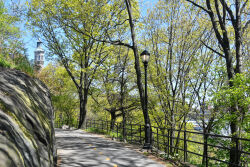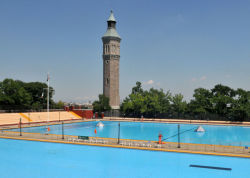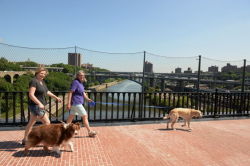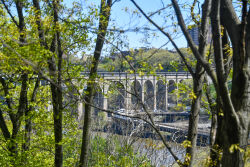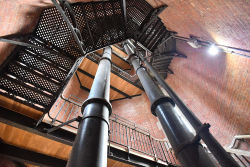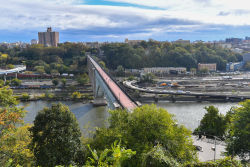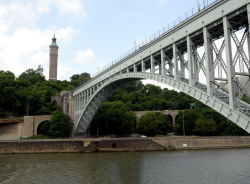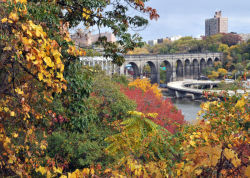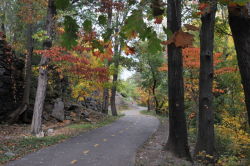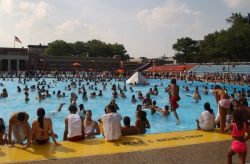Highbridge Park
Highbridge Park
What was here before?
From the 17th to the 19th centuries, this area was sparsely populated with farms and private estates. During the American Revolution, the Battle of Fort Washington took place in the vicinity. General George Washington used the Morris-Jumel Mansion, adjacent to the park’s southern end near Edgecombe Avenue and West 160th Street, as his headquarters in September and October 1776. In the northern portion of the park, was the site of Fort George, a fortification used to defend against the British in 1779. More than a century later, on the site of the no longer extant fort, a popular amusement park opened in 1895. With two Ferris wheels, three rollercoasters, and several hotels, it was known at the time to rival Coney Island until it burned down in 1913.
How did this site become a park?
Highbridge Park was assembled piecemeal between 1867 and the 1960s, with the bulk received through condemnation between 1895 and 1901. NYC Parks acquired the cliffside area from West 181st Street to Dyckman Street in 1902, and the parcel including Fort George Hill in 1928. In 1934, NYC Parks obtained the majestic Highbridge Tower and the site of old High Bridge Reservoir. Highbridge Park has a total of 103 acres of forested natural area and is 2.25 miles long.
One of Manhattan’s most picturesque landmarks, the water tower has looked over old High Bridge and the Harlem River valley since 1872. In 1958, the tower was rehabilitated and outfitted with a five-octave carillon which was financed by department store magnate, B. Altman, that operated until the early 1980s. Construction began in 2019 to stabilize the structure, repair the cast iron interior staircase and install new windows and lighting.
The Highbridge Recreation Center and Pool, one of eleven city pools built with labor supplied by the Works Progress Administration, were erected on the site of the former reservoir in 1936. The High Bridge and surrounding land came under NYC Parks’ jurisdiction in 1960.
In addition to the High Bridge, water tower, and recreation center, Highbridge Park boasts important natural assets including open vistas, and a striking geological formation of massive cliffs and large rock outcroppings.
A community-led effort, reinforced by the Highbridge Coalition, catalyzed support for the historic High Bridge's reopening in June 2015 after being closed for more than 40 years. The reconstructed landmark bridge reconnected Manhattan and Bronx and included repointing stone joints, reconditioning the original handrails, repainting the steel arch and adding lighting and a safety fence. The walkway is now embedded with bronze medallions that share the bridge’s history.
Highbridge Park is part of the Anchor Parks Initiative, a program to invest in larger parks that service focus points for the community that features a series of capital improvements. In 2021, the park was reconstructed to include a renovated Adventure Playground, new adult fitness area to the adjoining Sunken Playground, a transformed undeveloped area into a new synthetic turf soccer field, and installed lighting on the greenway to the High Bridge, improving access to the historic passageway between Manhattan and The Bronx.
What is this park named for?
Highbridge Park derives its name from New York City’s oldest standing bridge, the High Bridge (1848), which carried the Old Croton Aqueduct over the Harlem River as part of the first reliable and uninterrupted water supply system in New York City. As the City was devastated by fire and disease in 1830s, the inadequacy of the water system of wells and cisterns became apparent. The Croton River in northern Westchester County was found to be sufficient in both quantity and quality to serve the City’s needs. Begun in 1837, the delivery system was completed in 1848.
The Old Croton Aqueduct was the first of its kind constructed in the United States. The innovative system used a gravity feed, running 41 miles into the City through an enclosed masonry structure that crossed ridges, valleys, and rivers. The High Bridge soars 138 feet above the Harlem River, with a total length of 1,450 feet. The bridge was designed with a pedestrians-only walkway atop the Aqueduct. In the 1920s the bridge's center masonry arches were declared a hazard to navigation and replaced by a single steel span.
Check out your park's Vital Signs
Clean & Safe
Green & Resilient
Empowered & Engaged Users
Share your feedback or learn more about how this park is part of a
Vital Park System

